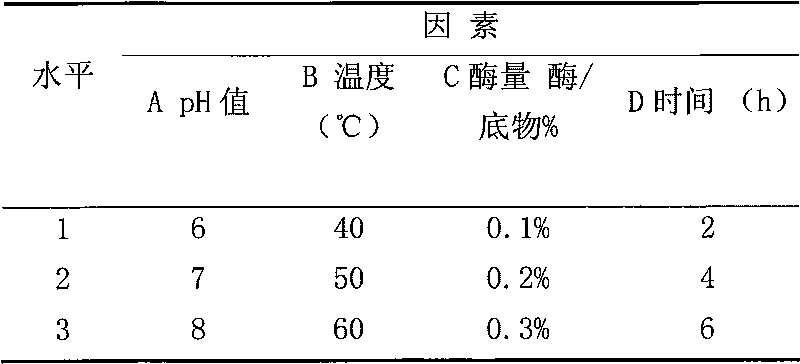Preparation method for sinonovacula constricta enzymolysis liquid with diversified bioactivities
A technology of razor clam enzymatic hydrolyzate and biological activity, which is applied in the field of preparation of razor clam enzymatic hydrolyzate, can solve the problems of restricting the development of razor clam meat tissue utilization, little research on biological activity, monotonous product varieties, etc. , to achieve the effect of treating and preventing tumors and fatigue diseases, good control, and low processing cost
- Summary
- Abstract
- Description
- Claims
- Application Information
AI Technical Summary
Problems solved by technology
Method used
Image
Examples
example 1
[0020] According to the above steps, mash the razor clam meat with tissue and use a homogenizer to make minced meat, weigh 30g, put it into a conical flask, add 50mL of water, add papain, adjust the pH value, hydrolyze at constant temperature, and inactivate the enzyme at high temperature (85°C for 10min) , the enzymolysis solution was centrifuged at 4500r / min for 20min, the supernatant was taken as the hydrolysis solution, and the volume was adjusted to 60mL for the determination of activity. Since temperature, enzyme amount, pH value and time are important factors that directly affect the hydrolysis effect of razor clam tissue, they were taken as orthogonal factors in this experiment, and three levels were selected to design L9 (3 4 ) orthogonal test, 9 groups of enzymatic hydrolyzate were obtained.
[0021] Table 1 Factor levels of enzymatic hydrolysis orthogonal experiment
[0022]
example 2
[0024] Antibacterial activity of tissue extracts detected by filter paper method: Escherichia coli (EC), Proteus vulgaris (PV), Staphylococcus aureus (SA), Enterobacter aerogenes (EA) and Bacillus subtilis Bacillus subtilis (BS) uses beef extract peptone medium, and lactic acid bacteria Lactobacterium delbruckii (LD) uses MRS medium. YPD medium for Saccharomyces cerevisiae (SC). The above-mentioned bacteria were inoculated in the corresponding liquid medium respectively, and cultured with shaking for 24 hours as indicator bacteria. Use a pipette gun to take 100 μL of the indicator bacteria solution on the corresponding solid medium, spread it evenly with a sterile triangular smear stick, then divide the plate into six areas, put a piece of filter paper in each area, and then pipette Pipette 10 μL of the enzymatic hydrolysis sample into the center of the filter paper and place in a 37°C incubator for incubation. Each treatment was repeated three times, the positive control wa...
example 3
[0026] superoxide anion radical (O 2- ) Determination of scavenging effect: Take pyrogallol 0.1mL in a test tube, add 5mL of Tris-HCl buffer solution with pH 8.2, add 0.25mL of enzymatic hydrolysis solution obtained by hydrolysis under different conditions, and mix quickly. React at 25°C for 15 minutes. Use a 1cm cuvette, use distilled water as a blank control, and measure the absorbance A at 320nm i , and determine the background to subtract the interference of the hydrolyzate itself. The calculation formula of enzymatic solution to superoxide anion free radical scavenging rate is as follows: scavenging rate S (%)=Ao-(A i -A j ) / Ao×100%. In the formula, Ao is the absorbance value of the reagent blank; A i is the absorbance value of the sample solution; A j is the absorbance value of the sample solution background. Although the superoxide anion radical (O 2- ) cannot directly induce lipid oxidation in biological and food systems, but it will generate highly active OH u...
PUM
 Login to View More
Login to View More Abstract
Description
Claims
Application Information
 Login to View More
Login to View More - R&D
- Intellectual Property
- Life Sciences
- Materials
- Tech Scout
- Unparalleled Data Quality
- Higher Quality Content
- 60% Fewer Hallucinations
Browse by: Latest US Patents, China's latest patents, Technical Efficacy Thesaurus, Application Domain, Technology Topic, Popular Technical Reports.
© 2025 PatSnap. All rights reserved.Legal|Privacy policy|Modern Slavery Act Transparency Statement|Sitemap|About US| Contact US: help@patsnap.com

